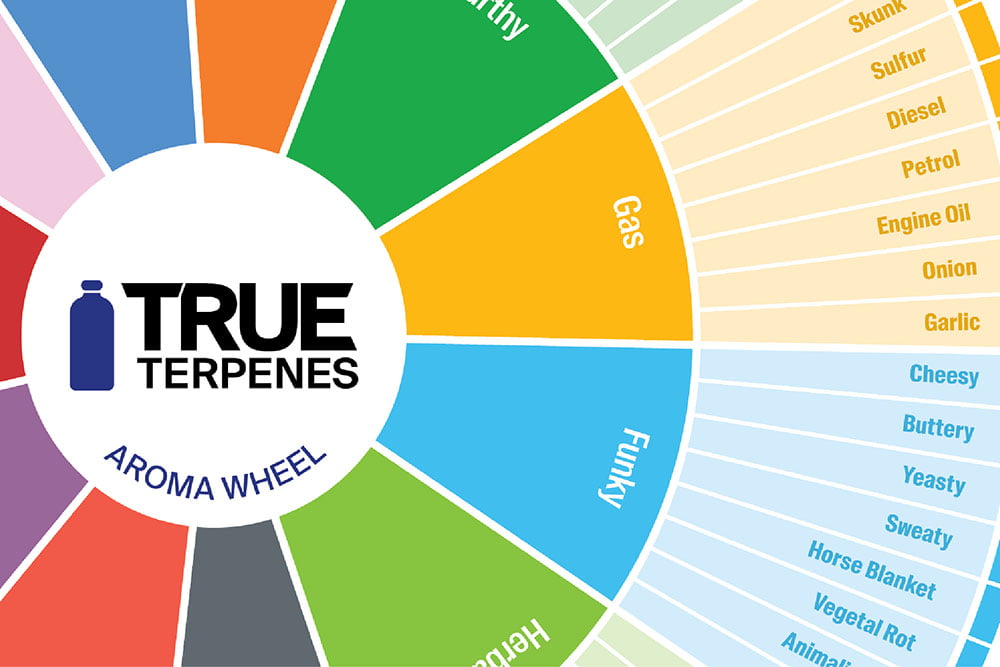November 4, 2017
Medicinal Properties Of Terpenes

Terpenes are About More Than Taste and Smell
Terpenes, the aromatic compounds found in thousands of plant species around the globe, are the agents responsible for the flavors and fragrances of the world around us. The effects of terpenes have been noted by scientists for decades now, however, it wasn’t until recently that the therapeutic properties of terpenes have begun to be explored. Here at True Terpenes, we want all of our customers to be as informed as possible when it comes to our products and, in today’s post, we are going to go over some of the most medicinally valuable terpenes available on the market. Continue reading below to learn more.
Nature’s Building Blocks
Even though most online articles tend to focus on terpenes found in cannabis plants, terpenes are found in pretty much every biological structure on Earth. Through years of research, scientists have managed to isolate certain terpene compounds that have proven to be beneficial in a therapeutic sense. Below, we have listed these terpenes.
- Limonene: The monoterpene limonene is largely responsible for the fragrance associated with citrus fruits. Limonene gives off a strong orange fragrance in its isolated form and has found widespread use in the food industry as a flavor additive, as an essential ingredient in many perfumes, and, from a medicinal standpoint, limonene has been used to reduce heartburn and treat gastric acid reflux. In addition to these uses, limonene is used as a natural, renewable solvent in cleaning products due to the fact that it helps to naturally dissolve oils and other lipids that are often found in stains. In high concentrations, limonene can be used to strip paint from surfaces and is regarded as an effective substitute to turpentine, meaning that it must be handled with care if it is not diluted.
- Myrcene: Another monoterpene, myrcene is found in hops, lemongrass, verbena, bay leaves, and wild thyme. This terpene is responsible for the “green hop aroma” that is found in beers that have been dry-hopped (a brewing practice in which hops are added to beer post-fermentation and at low temperatures in order to achieve a more hop-forward flavor). When inhaled, myrcene is described as having a resinous, slightly metallic, and herbaceous aroma. In traditional South American medicine, myrcene has been used in the form of Myrcia sphaerocarpa, a small, native shrub used in medicines to treat diarrhea, dysentery, hypertension, and diabetes.
- Pinene: Occurring naturally as two isomers, molecules with the exact same chemical formula but a different chemical structure, pinene is another monoterpene found abundantly in nature. The isomers that make up this terpene, known as a-pinene and ß-pinene are typically sourced from turpentine, a product produced by dry distillation coniferous wood, and make up the majority of the volume of the terpene. Both a-pinene and ß-pinene are found in pine and other coniferous trees and shrubs including sage, sagebrush, and Eucalyptus. On its own, a-pinene is found in rosemary, sassafras, bergamot, and olive, making it one of the most abundant, naturally-occurring terpenes. A-pinene is noted for its ability to inhibit root growth in many plant species and is excreted from the leaves of many plants species as a natural herbicide intended to prevent neighboring plants from competing against them for resources. From a medicinal standpoint, pinene can be used by humans in small doses as a bronchodilator and contains antibiotic, antibacterial, and anti-inflammatory properties.
- Linalool: The final monoterpenoid on our list, linalool, is found in hundreds of plant species including mint, cinnamon, birch, laurel, and some citrus fruits. Linalool is interesting in that it contains two enantiomers or two isomers that are nonsuperimposable (not identical) mirror images. This means that linalool contains two isomers that provide completely different aromas and flavors. S-linalool, the “left enantiomer, is found in palmarosa grass, coriander, sweet orange and is noted for having a sweet, floral scent. R-linalool, the “right” enantiomer if found in bay laurel, lavender, and basil and features a woody, astringent aroma. From a medicinal standpoint, linalool is used mainly as an anxiety reducing drug with some studies showing that linalool can be sued for its sedative and motor relaxant effects.
Thank you for taking the time to read our short blog post on some of the medicinal properties associated with some of the most popular terpenes. If you would like to view our product lines and the specific strains of terpenes that we offer at True Terpenes, please visit our website today. With over 50 terpenes to chose from, we are certain that you will find a product that can work for you.




